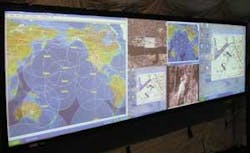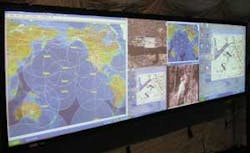Engineers at Spec Ops Inc., a defense contractor in Ashland, Va., needed a video processor to create a large-screen display.
Their customer, the U.S. Army’s 10th Mountain Division, needed a 16-foot by 5-foot, command-and-control screen to use in Afghanistan, displaying satellite feeds, maps and other key visuals in the division’s Joint Operations Center hub.
Spec Ops found a solution with six Spyder 353 video processors from Vista Systems, Phoenix, Ariz.
The Spyder can stretch a single 1080i input across three or more projectors for a seamless wide-screen display. It can mix sources in multiple windows, create picture-in-pictures (PIPs), and blend borders. Each unit can handle inputs including HD, DVI, Analog RGB, SDI, HD-SDI, analog beta cam, composite, or s-video. The Spyder 300 Series comprises three-rack-space video processing systems that support up to eight modules in a variety of input and output combinations. The model 353 has five inputs and three outputs.
“The military is interested in lightweight, rugged, highly deployable systems that hold up under duress and are usable year after year,” says Gil Sylvia, applications engineer with SpecOps. “Instead of creating the usual cubed videowall where information is lost between the cubes, Spyder enabled us to create a seamless large screen with multiple windowing which can be used with different sources simultaneously and instantaneously. Spyder also allows us to do two- or three-projector edgeblends. Spyder gives us total control of switching, seamless displays and easy windowing.”
For more information, see www.vistasystems.net.




